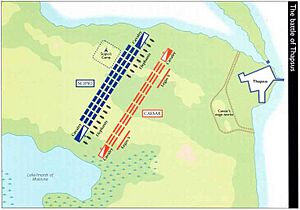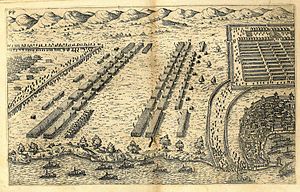Battle of Thapsus facts for kids
Quick facts for kids Battle of Thapsus |
|||||||
|---|---|---|---|---|---|---|---|
| Part of Caesar's Civil War | |||||||
 Initial troop deployment of the battle |
|||||||
|
|||||||
| Belligerents | |||||||
| Populares | Optimates Numidia |
||||||
| Commanders and leaders | |||||||
| Gaius Julius Caesar | Metellus Scipio Marcus Petreius Juba I of Numidia Titus Labienus Lucius Afranius Publius Attius Varus (fleet commander) Vergilius (garrison commander of Thapsus) |
||||||
| Units involved | |||||||
|
Optimates' army Juba's army |
||||||
| Strength | |||||||
| 50,000−70,000 (at least 12 legions), 5,000 cavalry | 70,000−90,000 (at least 12 legions), 14,500 cavalry Juba's allied troops with 60 elephants |
||||||
| Casualties and losses | |||||||
| Nearly 1,000 | About 10,000 | ||||||
The Battle of Thapsus was a major fight that happened on April 6, 46 BC. It took place near a city called Thapsus in what is now Tunisia. In this battle, the army of Julius Caesar defeated the forces of his enemies, known as the Optimates. Their leader was Metellus Scipio. This victory was a big step for Caesar in the Caesar's Civil War.
Contents
Why the Battle Happened
The Roman Republic was in a civil war starting in 49 BC. Julius Caesar was a powerful Roman general. He had just finished fighting in Gaul (modern France). The Senate told him to send his army home. But Caesar believed his political enemies in Rome wanted to arrest him. So, he refused to disband his army.
Instead, Caesar crossed the Rubicon river with his army. This was against Roman law. He marched towards Rome. His enemies, the Optimates, were not ready for a fight. They fled to Greece, led by Pompey. Caesar and his supporters, the Populares, followed them.
Caesar's army was smaller than Pompey's. He lost a battle at Dyrrhachium. But he recovered and won a big victory at Pharsalus. Pompey then fled to Egypt and was killed there.
The remaining Optimates didn't give up. They gathered in the African provinces. Their main leaders were Marcus Cato and Caecilius Metellus Scipio. Other important figures included Titus Labienus and King Juba I of Numidia. King Juba was a strong local ally. After dealing with other areas, Caesar went to Africa to face them.
Caesar's Journey to Thapsus
Caesar gathered his soldiers in Sicily. He sailed to Africa on December 28. A storm scattered his ships. He landed with only a small part of his army. He tried to take the city of Hadrumetum, but it was too strong.
Caesar then marched south. Enemy cavalry, mostly from Numidia, kept bothering his army. They tried to trap him. But Caesar was a very skilled commander. He kept his forces moving and reached Ruspina.
Fighting Near Ruspina
Caesar made Ruspina his main camp. On January 1, he got more soldiers and supplies. On January 4, Caesar went out to find food for his army. He took about half his men. The Optimates, led by Petreius and Labienus, attacked him. Caesar's forces almost lost, but he managed to get his men back to Ruspina.
Caesar decided to stay at Ruspina and make his camp stronger. He waited for more troops to arrive. The Optimates were gathering their forces near Hadrumetum. Scipio arrived with the main army. They had many soldiers and cavalry.
More of Caesar's legions arrived. With these new soldiers, Caesar went on the attack. He defeated some of the Optimates' cavalry in a small fight near Ruspina. The Optimates then called on King Juba I of Numidia to join them with his army.
Moving Towards Uzitta
Caesar kept pushing forward. He marched towards Uzitta, which was an important water source for the Optimates. He wanted to force his enemies into a big battle. Even with King Juba's army, Scipio refused to attack Caesar's strong positions.
More of Caesar's experienced legions arrived, making his army even stronger. Caesar started building long lines of defenses from his camp to Uzitta. He also set up catapults to attack Uzitta. This caused some of the Optimates' soldiers to switch sides and join Caesar.
Still, the Optimates avoided a direct battle. So, Caesar went back to Ruspina. Two more legions joined him. Because of supply problems, Caesar had to march his whole army south to find food. He also sent his ships to block the ports of Hadrumetum and Thapsus.
Getting Ready for Battle
In early February, Caesar reached Thapsus. He surrounded the city with two lines of defenses. His ships were already blocking the city from the sea. There was a marsh nearby, leaving only two ways to approach the city by land.
Caesar blocked the southern approach with strong defenses. This meant his enemies had to either attack these defenses or march around the marsh. Scipio and the Optimates decided to march around the marsh to the eastern side.
Scipio set up his army opposite Caesar's. He wanted to protect his workers who were building a camp. Caesar knew that Scipio's soldiers were tired from marching all day. So, he got his well-rested army ready to fight them.
The Armies Face Off
Caesar had twelve legions at Thapsus. Some were new, and some were experienced. His experienced legions had been fighting for many years and were smaller than usual. He also had many archers, slingers, and cavalry. In total, Caesar had about 60,000 to 70,000 soldiers.
The Optimates had eight Roman legions and three Numidian legions. This was about 55,000 legionaries. They also had a lot of cavalry, light infantry, and 60 elephants. Their total army was around 90,000 soldiers.
The Battle Begins
Scipio arranged his legions in three lines in the middle. His cavalry and light infantry were on the sides. He placed his elephants in front of the sides of his army. Caesar left two new legions to continue surrounding Thapsus.
Caesar also arranged his legions in three lines. He put his archers, slingers, and cavalry on the sides. He split his Fifth Legion into two parts. These parts were kept behind the sides to fight the elephants. Caesar himself commanded the right side of his army.
The two armies faced each other. No one moved for a while. Then, a trumpeter from Caesar's Seventh Legion sounded the attack. Caesar saw his right side surge forward and ordered a general advance.
Caesar's archers on the right side attacked the elephants facing them. This made the elephants panic. They turned around and ran into their own soldiers. The elephants on the other side charged towards Caesar's left side. Caesar's light infantry and cavalry moved out of the way. This cleared a path for a part of the Legio V Alaudae (Fifth Legion).
These soldiers bravely faced the elephants. They stabbed their spears at the elephants' eyes and weak spots. They also blew their trumpets loudly, which scared the animals. The elephants turned back and ran into their own lines, crashing into Scipio's right side.
After losing the elephants, Metellus Scipio's army started to fall apart. His left side broke first, and the rest followed. Caesar's cavalry outsmarted the enemy. They destroyed the enemy's fortified camp. This forced Scipio's army to retreat.
During the battle, the soldiers inside Thapsus tried to attack Caesar's siege works. But the two legions Caesar had left there pushed them back. These legions then marched south to help attack Afranius and Juba's camp. Together, they attacked and took over Afranius's camp.
They were getting ready to attack the Numidians. But before they could, Juba's allied troops left the area. The battle was decided. Caesar went to the Optimates' main camp and found it already taken. Here, Caesar's soldiers became very angry and continued fighting, even after Caesar tried to stop them. About ten thousand enemy soldiers were killed.
What Happened After
Scipio, Labienus, Juba, Afranius, and Petreius managed to escape the Battle of Thapsus. Labienus, along with Pompey's sons, fled to Spain. There, they planned to raise another army.
Afranius and Faustus Cornelius Sulla (Sulla's son) gathered some survivors. They started to rob areas in eastern Mauretania. But they were caught by Publius Sittius, a Roman commander working for King Bocchus II, who was Caesar's ally. Afranius and Sulla were executed a few days later.
Juba and Petreius fled to Numidia. But Sittius was closing in on them. They decided to fight each other to die honorably. Petreius killed Juba, and then had a slave kill him.
After the battle, Caesar continued to surround Thapsus. The city eventually fell. He then went to Utica, where Cato was stationed. When Cato heard about his allies' defeat, he took his own life. Caesar was reportedly sad about this.
Scipio also tried to escape to Roman Spain. He gathered a small fleet and the remaining Optimate leaders. But bad weather forced them back to the African coast. They were caught by Sittius and his fleet. After losing a naval battle, Scipio also died.
The Battle of Thapsus brought peace to Africa. Caesar left and returned to Rome. However, Caesar's enemies were not completely defeated. Labienus, Pompey's sons, and others managed to gather another army in Spain. The civil war was not over yet, and the Battle of Munda would follow. The Battle of Thapsus is known as the last major battle in the West where war elephants were used.
Images for kids




